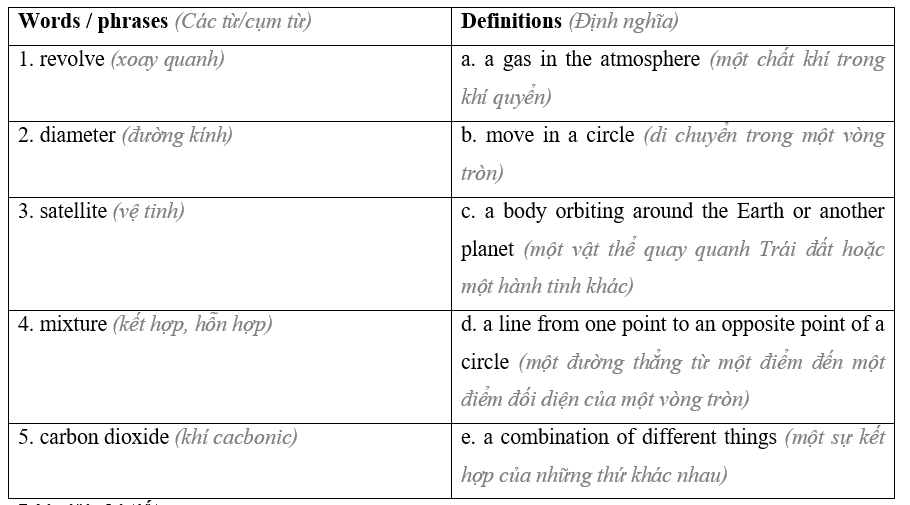Tiếng Anh 8 CLIL 5 Science1. In pairs, ask and answer the following questions about the Earth: 2. Match the words / phrases below with their definitions.3. Listen and read the fact file below and check your answers in Exercise 1. 4. In pairs, close the book. Ask and answer about the Earth? 5. In groups, do an Internet search about the Earth. Find out 5 misconceptions about the Earth and then correct the misconceptions. Include these findings in a PowerPoint presentation and present them to the class. Add pictures.
Lựa chọn câu để xem lời giải nhanh hơn
Bài 1 1. In pairs, ask and answer the following questions about the Earth: (Theo cặp, hỏi và trả lời các câu hỏi sau về Trái đất:) 1. Which planet in the Solar System has life? (Hành tinh nào trong Hệ Mặt trời có sự sống?) 2. How old is the Earth as estimated by scientists? (Trái đất bao nhiêu tuổi theo ước tính của các nhà khoa học?) 3. What is the Greek name for Earth? (Tên Hy Lạp của Trái đất là gì?) 4. What percent of the Earth’s surface is covered by water? (Bao nhiêu phần trăm bề mặt Trái đất được bao phủ bởi nước?) 5. What makes up the air of the Earth? (Cái gì tạo nên không khí của Trái đất?) Lời giải chi tiết: 1. the Earth (Trái Đất) 2. Today, we know from radiometric dating that Earth is about 4.5 billion years old. (Ngày nay, chúng ta biết từ việc xác định niên đại bằng phép đo phóng xạ rằng Trái đất khoảng 4,5 tỷ năm tuổi.) 3. Gaea, also called Ge, Greek personification of the Earth as a goddess. (Gaea, còn được gọi là Ge, hiện thân của Trái đất trong tiếng Hy Lạp với tư cách là một nữ thần.) 4. About 71 percent of the Earth's surface is water-covered. (Khoảng 71 phần trăm bề mặt Trái đất được bao phủ bởi nước.) 5. The air in Earth's atmosphere is made up of approximately 78 percent nitrogen and 21 percent oxygen. (Không khí trong bầu khí quyển của Trái đất được tạo thành từ khoảng 78% nitơ và 21% oxy.) Bài 2 2. Match the words / phrases below with their definitions. (Nối các từ/cụm từ dưới đây với định nghĩa của chúng.)
Lời giải chi tiết:
Bài 3 3. Listen and read the fact file below and check your answers in Exercise 1. (Nghe và đọc tệp tin thực tế bên dưới và kiểm tra câu trả lời của bạn trong Bài tập 1.) Earth is the third planet from the Sun. It is currently the only planet where life is present. Key Facts & Summary - It is estimated that our Earth is around 4.5 billion years old. - Earth was formed at around the same time as the rest of our Solar System. - Earth revolves around the Sun once every 365.25 days - this is known as one Earth year. - Earth is the fifth largest planet of the solar system. It has a diameter of 6,371 km / 3,958 mi. - The name Earth, which simply translates to “the ground”, is at least 1,000 years old. The Greek name for Earth was Gaia, which means “Mother Earth”. - Only 3% of Earth’s water is fresh and the remaining 97% is salty. - 71% of the Earth’s surface is covered by water and only 29% is covered by land. - The air that we breathe is the mixture of nitrogen, oxygen, argon, and carbon dioxide. Without them, we couldn’t live. - Earth has only one satellite - the Moon, but it also has a couple of temporal artificial satellites. Phương pháp giải: Tạm dịch: Trái đất là hành tinh thứ ba tính từ Mặt trời. Nó hiện là hành tinh duy nhất có sự sống. Sự kiện chính & Tóm tắt - Người ta ước tính rằng Trái đất của chúng ta khoảng 4,5 tỷ năm tuổi. - Trái đất được hình thành cùng thời điểm với phần còn lại của Hệ Mặt trời. - Trái đất quay quanh Mặt trời cứ sau 365,25 ngày một lần - đây được gọi là một năm Trái đất. - Trái đất là hành tinh lớn thứ năm của hệ mặt trời. Nó có đường kính 6.371 km / 3.958 dặm. - Cái tên Earth, dịch đơn giản là “mặt đất”, có ít nhất 1.000 năm tuổi. Tên tiếng Hy Lạp của Trái đất là Gaia, có nghĩa là "Đất mẹ". - Chỉ 3% nước trên Trái đất là nước ngọt và 97% còn lại là nước mặn. - 71% bề mặt Trái đất được bao phủ bởi nước và chỉ 29% được bao phủ bởi đất liền. - Không khí mà chúng ta hít thở là hỗn hợp của nitơ, oxy, argon và carbon dioxide. Không có họ, chúng tôi không thể sống. - Trái đất chỉ có một vệ tinh - Mặt trăng, nhưng nó cũng có một vài vệ tinh nhân tạo tạm thời. Lời giải chi tiết: Đang cập nhật! Bài 4 4. In pairs, close the book. Ask and answer about the Earth? (Theo cặp, đóng sách lại. Hỏi và trả lời về Trái Đất?) A: What is the diameter of the Earth? (Đường kính của Trái đất là gì?) B: It is 6,371 km. (Là 6371 km.) Lời giải chi tiết: A: What is the Greek name for Earth? (Tên Hy Lạp của Trái đất là gì?) B: The name Earth, which simply translates to “the ground”, is at least 1,000 years old. The Greek name for Earth was Gaia, which means “Mother Earth”. (Cái tên Earth, dịch đơn giản là “mặt đất”, có ít nhất 1.000 năm tuổi. Tên tiếng Hy Lạp của Trái đất là Gaia, có nghĩa là "Đất mẹ".) Bài 5 5. In groups, do an Internet search about the Earth. Find out 5 misconceptions about the Earth and then correct the misconceptions. Include these findings in a PowerPoint presentation and present them to the class. Add pictures. (Theo nhóm, thực hiện tìm kiếm trên Internet về Trái đất. Cùng tìm hiểu 5 quan niệm sai lầm về Trái đất và khắc phục những quan niệm sai lầm đó. Bao gồm những phát hiện này trong một bản trình bày PowerPoint và trình bày chúng trước lớp. Thêm hình ảnh.) Lời giải chi tiết: 5 misconceptions about the Earth: (5 quan niệm sai lầm về Trái đất:) - The Great Wall of China is visible from space. (Vạn Lý Trường Thành của Trung Quốc có thể nhìn thấy từ không gian) - In the summer, the Earth is closer to the Sun, and in the winter vice versa. (Vào mùa hè, Trái đất gần Mặt trời hơn và vào mùa đông thì ngược lại.) - Dinosaurs are extinct. (Khủng long đã tuyệt chủng.) - South of the Equator toilets flush and tornadoes spin in the opposite direction. (Nhà vệ sinh ở phía nam Xích đạo xả nước và lốc xoáy quay theo hướng ngược lại.) - Large earthquakes increasing in frequency. (Các trận động đất lớn ngày càng gia tăng về tần suất.) Correct the misconceptions: (Khắc phục những quan niệm sai lầm:) - In fact, according to NASA, it is very difficult to see or photograph the Great Wall from low Earth orbit. It very rarely can be visible in the low orbit, and to an aided eye, under special conditions. (Trên thực tế, theo NASA, rất khó để nhìn thấy hoặc chụp ảnh Vạn Lý Trường Thành từ quỹ đạo Trái đất thấp. Nó rất hiếm khi có thể được nhìn thấy ở quỹ đạo thấp và bằng mắt được hỗ trợ, trong những điều kiện đặc biệt.) - The seasons exist because Earth’s axis is today tilted 23.5 degrees from the plane of its orbit around the sun. But this tilt changes. During a cycle that averages about 40,000 years, the tilt of the axis varies between 22.1 and 24.5 degrees. Because this tilt changes, the seasons as we know them can become exaggerated. More tilt means more severe seasons – warmer summers and colder winters; less tilt means less severe seasons – cooler summers and milder winters. (Các mùa tồn tại vì trục Trái đất ngày nay nghiêng 23,5 độ so với mặt phẳng quỹ đạo của nó quanh mặt trời. Nhưng độ nghiêng này thay đổi. Trong một chu kỳ trung bình khoảng 40.000 năm, độ nghiêng của trục thay đổi trong khoảng 22,1 đến 24,5 độ. Bởi vì độ nghiêng này thay đổi, các mùa như chúng ta biết có thể bị phóng đại. Độ nghiêng nhiều hơn có nghĩa là các mùa khắc nghiệt hơn - mùa hè ấm hơn và mùa đông lạnh hơn; độ nghiêng ít hơn có nghĩa là các mùa ít khắc nghiệt hơn - mùa hè mát mẻ hơn và mùa đông ôn hòa hơn.) - Yes, most of them are extinct. But not the avian dinosaurs. Birds (Aves), also known as avian dinosaurs are still well and alive. (Vâng, hầu hết trong số họ đã tuyệt chủng. Nhưng không phải khủng long gia cầm. Chim (Aves) hay còn gọi là khủng long bay vẫn sống khỏe mạnh.) - The Coriolis force on Earth is very weak. The Coriolis effect may play a small role in the direction of a tornado’s spin – if the circumstances are right. More often than not, however, that direction is determined by the storm system that spawned the twister in the first place. The Coriolis effect also isn’t strong enough to influence the way a normal sink drains. (Lực Coriolis trên Trái đất rất yếu. Hiệu ứng Coriolis có thể đóng một vai trò nhỏ trong hướng quay của cơn lốc xoáy – nếu hoàn cảnh phù hợp. Tuy nhiên, thường xuyên hơn không, hướng đó được xác định bởi hệ thống bão đã tạo ra gió xoáy ngay từ đầu. Hiệu ứng Coriolis cũng không đủ mạnh để ảnh hưởng đến cách thoát nước của bồn rửa bình thường.) - Scientists have analyzed the historical record and found that the increase in seismic activity was likely due to mere chance. Peter Shearer at Scripps Institution of Oceanography and Philip Stark at the University of California, Berkeley examined the global frequency of large magnitude earthquakes from 1900 to 2011. They discovered that while the frequency of magnitude 8.0 and higher earthquakes has been slightly elevated since 2004 – at a rate of about 1.2 to 1.4 earthquakes per year – the increased rate was not statistically different from what one might expect to see from random chance. The results of the study were published on January 17, 2012, in Proceedings of the National Academy of Sciences. (Các nhà khoa học đã phân tích hồ sơ lịch sử và phát hiện ra rằng sự gia tăng hoạt động địa chấn có thể chỉ là do ngẫu nhiên. Peter Shearer tại Viện Hải dương học Scripps và Philip Stark tại Đại học California, Berkeley đã kiểm tra tần suất toàn cầu của các trận động đất có cường độ lớn từ năm 1900 đến năm 2011. Họ phát hiện ra rằng mặc dù tần suất của các trận động đất có cường độ từ 8,0 trở lên đã tăng nhẹ kể từ năm 2004 – tại tỷ lệ khoảng 1,2 đến 1,4 trận động đất mỗi năm – tỷ lệ gia tăng không khác biệt về mặt thống kê so với những gì người ta có thể mong đợi nhìn thấy từ cơ hội ngẫu nhiên. Kết quả nghiên cứu đã được công bố vào ngày 17 tháng 1 năm 2012, trong Kỷ yếu của Viện Hàn lâm Khoa học Quốc gia.)
>> Học trực tuyến lớp 8 trên Tuyensinh247.com. Đầy đủ khoá học các bộ sách: Kết nối tri thức với cuộc sống; Chân trời sáng tạo; Cánh diều. Cam kết giúp học sinh lớp 8 học tốt, hoàn trả học phí nếu học không hiệu quả. PH/HS tham khảo chi tiết khoá học tại: Link
|





















